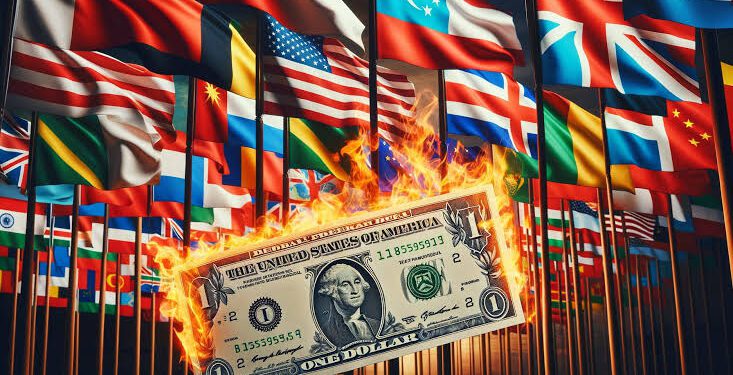The global dominance of the US dollar is facing significant challenges. A coalition of 12 countries has officially moved to abandon the dollar in favor of local currencies for cross-border trade. This move marks a critical shift in the global financial system. Emerging economies are now eager to boost the value of their own currencies and reduce their reliance on the US dollar. The new development suggests that the power of the USD is no longer guaranteed, and countries are positioning themselves for a more balanced global currency landscape.
The Rise of De-Dollarization
The de-dollarization movement has steadily gained traction, particularly after the US imposed sanctions on Russia in February 2022. In response, both Russia and China launched extensive diplomatic efforts to encourage other countries to abandon the US dollar. These efforts have gained considerable attention, as they offer emerging economies the opportunity to strengthen their currencies and reduce exposure to a dollar-dominated global economy.
The initiative has received a significant boost, with several countries now opting to settle their international transactions in their own currencies. These nations aim to build their economic sovereignty by reducing the risk posed by external influences, especially those tied to the US dollar. The move to local currencies is seen as an effort to gain better control over financial exchanges and mitigate vulnerabilities tied to dollar fluctuations.
The Commonwealth of Independent States Leads the Way
The Commonwealth of Independent States (CIS), comprising 12 countries, has emerged as the front-runner in the de-dollarization movement. These nations have agreed to settle over 85% of their cross-border trade in local currencies. In 2024, only 15% of transactions within the CIS were conducted in US dollars. This dramatic shift highlights the growing discontent with the dollar’s hegemony and suggests that de-dollarization is gathering pace.
Russian President Vladimir Putin addressed the growing trend during the CIS summit, where he remarked on the increasing use of national currencies in trade. He noted that the share of local currencies in mutual payments among CIS members had already surpassed 85%. Putin’s comments underscored the growing importance of this movement and its potential to reshape the global financial system.
The Impact of De-Dollarization on Global Markets
De-dollarization has the potential to disrupt the global economy by reducing the USD’s role in international trade. The US dollar has long been the dominant currency for global transactions, but that dominance is under threat as more nations seek alternatives. As more countries move toward using their local currencies, the demand for the US dollar may decrease, leading to a reduction in its value.
In response, many emerging economies are diversifying their reserves by increasing their holdings in gold and other assets. This diversification could provide greater economic stability and reduce reliance on the volatile movements of the dollar. Over the next few decades, we may see a shift in global trade patterns, with local currencies playing a larger role in cross-border transactions.
The Road Ahead: A Turning Point for the Dollar
The ongoing de-dollarization trend signals a critical turning point for the US dollar’s position in the global economy. As more countries reject dollar in favor of their own currencies, US may lose some of its economic leverage. The growing desire for financial independence and sovereignty among emerging economies could weaken the dollar’s influence in global trade.
While US dollar will remain a powerful currency for the future, the rise of local currencies represents a significant shift. The next few decades could see a further erosion of dollar’s dominance, changing the landscape of global trade & finance. The de-dollarization movement is gaining ground, and its full impact on the global economy remains to be seen.
Related Stories:
BRICS Moving Away From the De-Dollarization Agenda
BRICS Promoting the Idea of De dollarization.
Pakistan To Face Double Trouble if BRICS Threatened the US Dollar
















